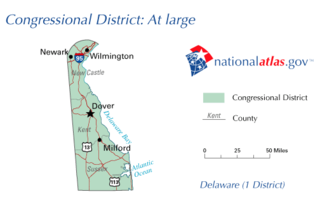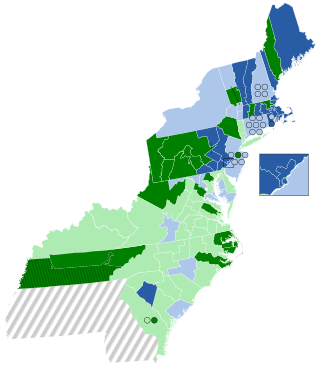
The 17th United States Congress was a meeting of the legislative branch of the United States federal government, consisting of the United States Senate and the United States House of Representatives. While its term was officially March 4, 1821, to March 4, 1823, during the fifth and sixth years of James Monroe's presidency, its first session began on December 3, 1821, ending on May 8, 1822, and its second session began on December 2, 1822, to March 3, 1823. The apportionment of seats in the House of Representatives was based on the 1810 United States census. Both chambers had a Democratic-Republican majority.
Delaware became a U.S. state in 1787, which allowed it to send congressional delegations to the United States Senate and United States House of Representatives beginning with the 1st United States Congress in 1789. Voters in each state elect two senators to serve for six years, and members of the House to two-year terms. Before 1914 United States Senators were chosen by the Delaware General Assembly and before 1935 all congressional terms began March 4.

Delaware's at-large congressional district is a congressional district that includes the entire U.S. state of Delaware. It is the nation's oldest congressional district, having existed uninterrupted since the 1st United States Congress in 1789. It is also the most populous congressional district in the nation. Delaware has always had only one member of the United States House of Representatives, except for a single decade from 1813 and 1823, when the state had two at-large members. The two seats were filled by a statewide ballot, with the two candidates receiving the highest votes being elected.

The 1822–23 United States House of Representatives elections were held on various dates in various states between July 1, 1822, and August 14, 1823. Each state set its own date for its elections to the House of Representatives before the first session of the 18th United States Congress convened on December 1, 1823. They occurred during President James Monroe's second term.
The 1814–15 United States House of Representatives elections were held on various dates in various states between April 26, 1814 and August 10, 1815. Each state set its own date for its elections to the House of Representatives before the first session of the 14th United States Congress convened on December 4, 1815. They occurred during President James Madison's second term. Elections were held for all 182 seats, representing 18 states.

The 1812–13 United States House of Representatives elections were held on various dates in various states between August 3, 1812 and April 30, 1813. Each state set its own date for its elections to the House of Representatives before the first session of the 13th United States Congress convened on May 24, 1813. They coincided with James Madison being re-elected president.

The 1796–97 United States House of Representatives elections took place in the various states took place between August 12, 1796, and October 15, 1797. Each state set its own date for its elections to the House of Representatives. The size of the House increased to 106 seats after Tennessee became the 16th state to join the union. The first session of the 5th United States Congress was convened on May 15, 1797, at the proclamation of the new President of the United States, John Adams. Since Kentucky and Tennessee had not yet voted, they were unrepresented until the second session began on November 13, 1797.

The 1794–95 United States House of Representatives elections were held on various dates in various states between August 25, 1794, and September 5, 1795 (Kentucky). Each state set its own date for its elections to the House of Representatives before the first session of the 4th United States Congress convened on December 7, 1795. They were held during President George Washington's second term. Elections were held for all 105 seats, representing 15 states.

The 1792–93 United States House of Representatives elections were held on various dates in various states between August 27, 1792 and September 6, 1793. Each state set its own date for its elections to the House of Representatives before the first session of the 3rd United States Congress convened on December 2, 1793. With the addition of the new state of Kentucky's representatives, and the congressional reapportionment based on the 1790 United States census, the size of the House increased to 105 seats.

The 1788–89 United States House of Representatives elections were the first U.S. House of Representatives elections following the adoption of the Constitution of the United States. Each state set its own date for its congressional elections, ranging from November 24, 1788, to March 5, 1789, before or after the first session of the 1st United States Congress convened on March 4, 1789. They coincided with the election of George Washington as the first president of the United States.

The 1821 United States House of Representatives elections in New York were held from April 24 to 26, 1821, to elect 27 U.S. Representatives to represent the State of New York in the United States House of Representatives of the 17th United States Congress.

The 1822 United States House of Representatives elections in New York were held from November 4 to 6, 1822, to elect 34 U.S. Representatives to represent the State of New York in the United States House of Representatives of the 18th United States Congress.

The 1824 United States House of Representatives elections in New York were held from November 1 to 3, 1824, to elect 34 U.S. Representatives to represent the State of New York in the United States House of Representatives of the 19th United States Congress.

The 1822–23 United States Senate elections were held on various dates in various states. As these U.S. Senate elections were prior to the ratification of the Seventeenth Amendment in 1913, senators were chosen by state legislatures. Senators were elected over a wide range of time throughout 1822 and 1823, and a seat may have been filled months late or remained vacant due to legislative deadlock. In these elections, terms were up for the senators in Class 2.

Vermont gained two seats after the 1810 census. Rather than re-district, however, Vermont replaced its districts with a single at-large district. It would continue to use an at-large district in 1814, 1816, and 1818, then one more time in 1822.

Vermont lost one seat in reapportionment following the 1820 United States census. For the 1822 election, Vermont switched back to using a single at-large district. This would be the last year that Vermont would use an at-large district until 1932, when its representation was reduced to a single seat. Vermont elected its members September 3, 1822.

A special election was held in Delaware's at-large congressional district on October 1, 1822 to fill a vacancy left by the resignation of Caesar A. Rodney (DR) on January 24, 1822, having been elected to the Senate. This election was held on the same day as the general elections for Congress in Delaware.

Indiana gained two seats in reapportionment following the 1820 United States Census, and elected its members August 5, 1822.

The 2014 United States House of Representatives election in Delaware was held on Tuesday, November 4, 2014 to elect the U.S. representative from Delaware's at-large congressional district, who will represent the state of Delaware in the 114th United States Congress. The election coincided with the election of a U.S. Senator from Delaware and other federal and state offices. Incumbent Democratic Congressman John Carney won re-election to a third term in office.

The 2024 Delaware gubernatorial election will be held on November 5, 2024, to elect the governor of the U.S. state of Delaware, concurrently with the 2024 U.S. presidential election, as well as elections to the United States Senate, elections to the United States House of Representatives, and various state and local elections. Incumbent Democratic Governor John Carney is term-limited and cannot seek re-election to a third term in office. Primary elections will take place on September 3, 2024.














